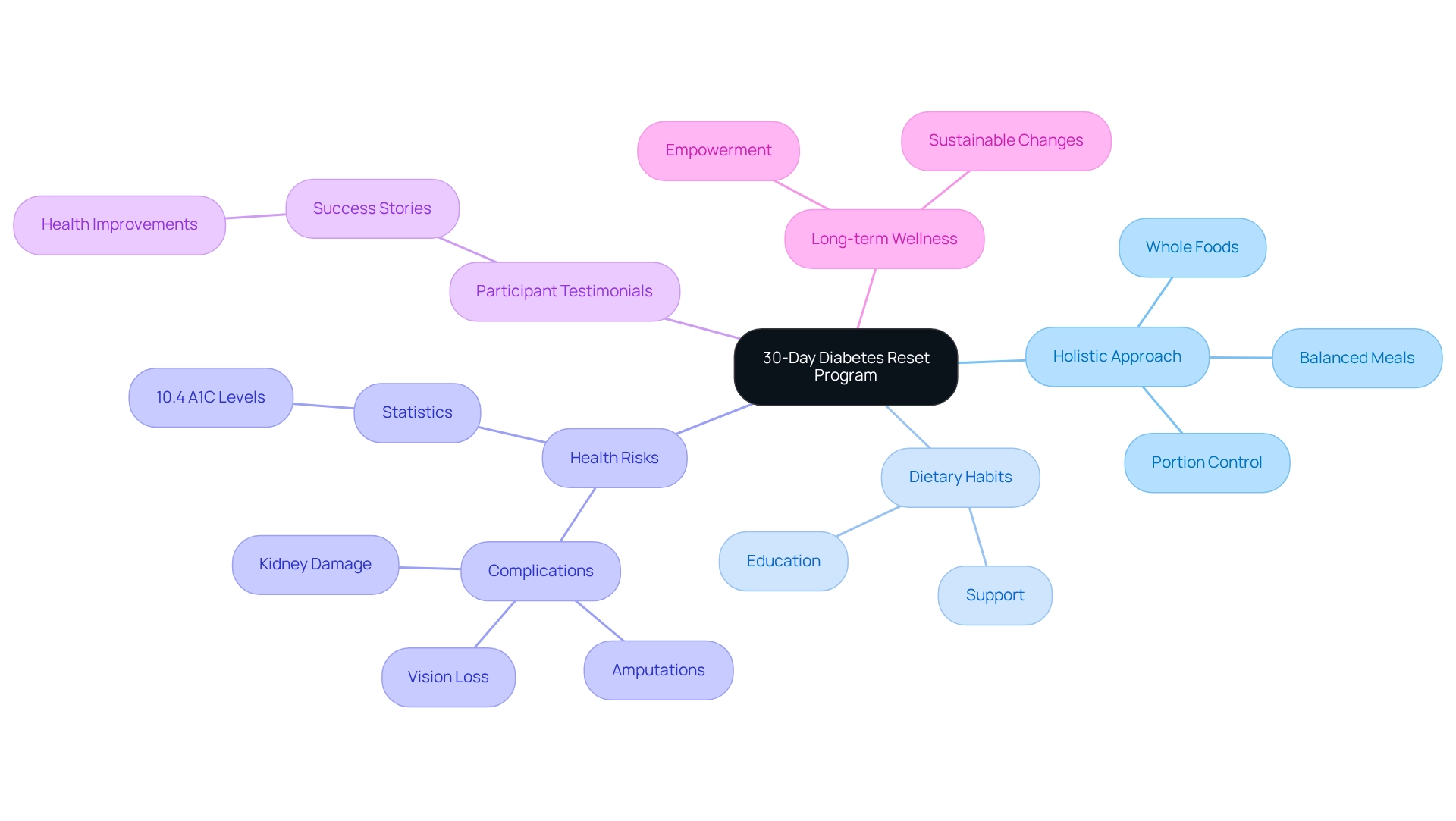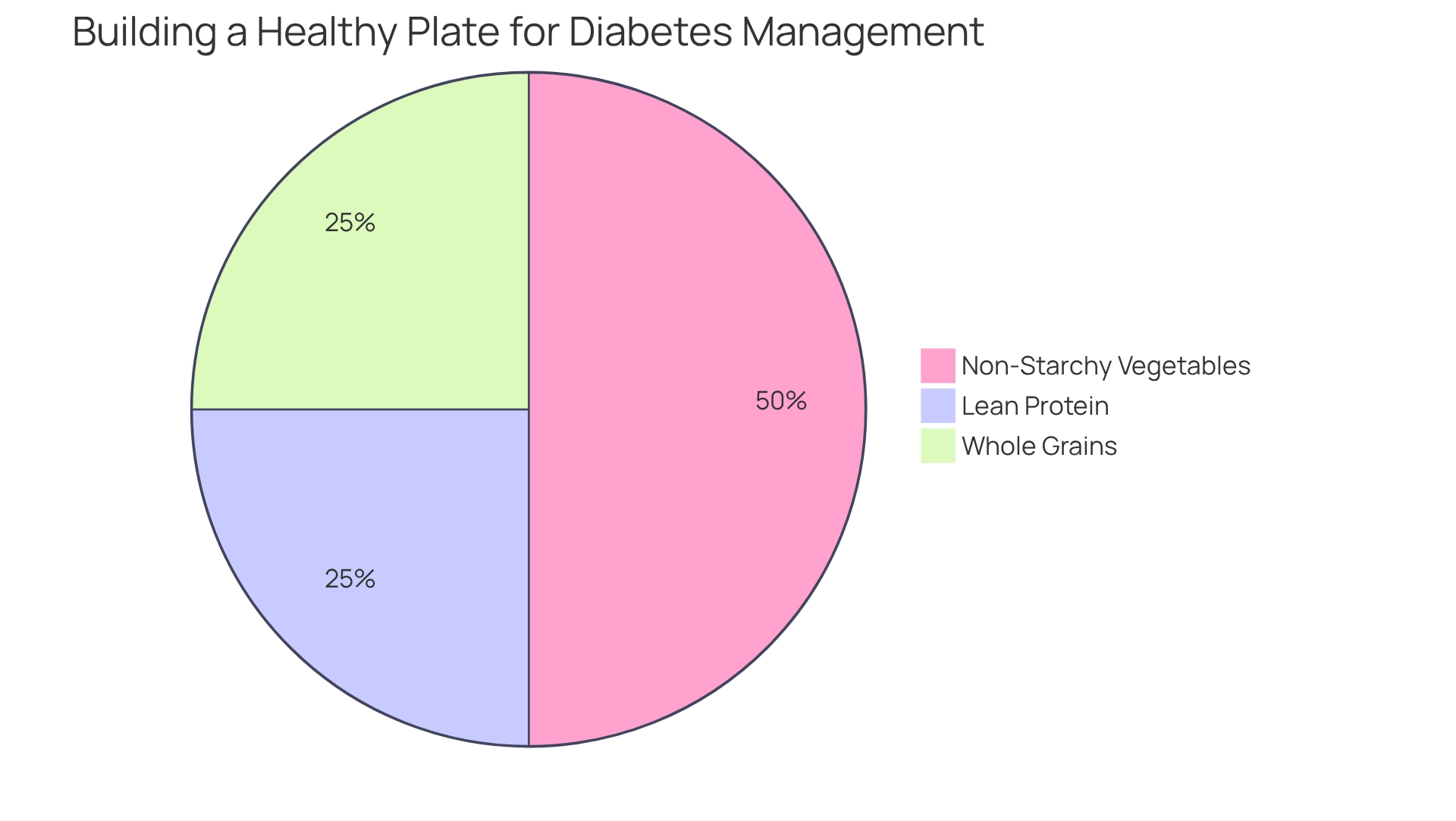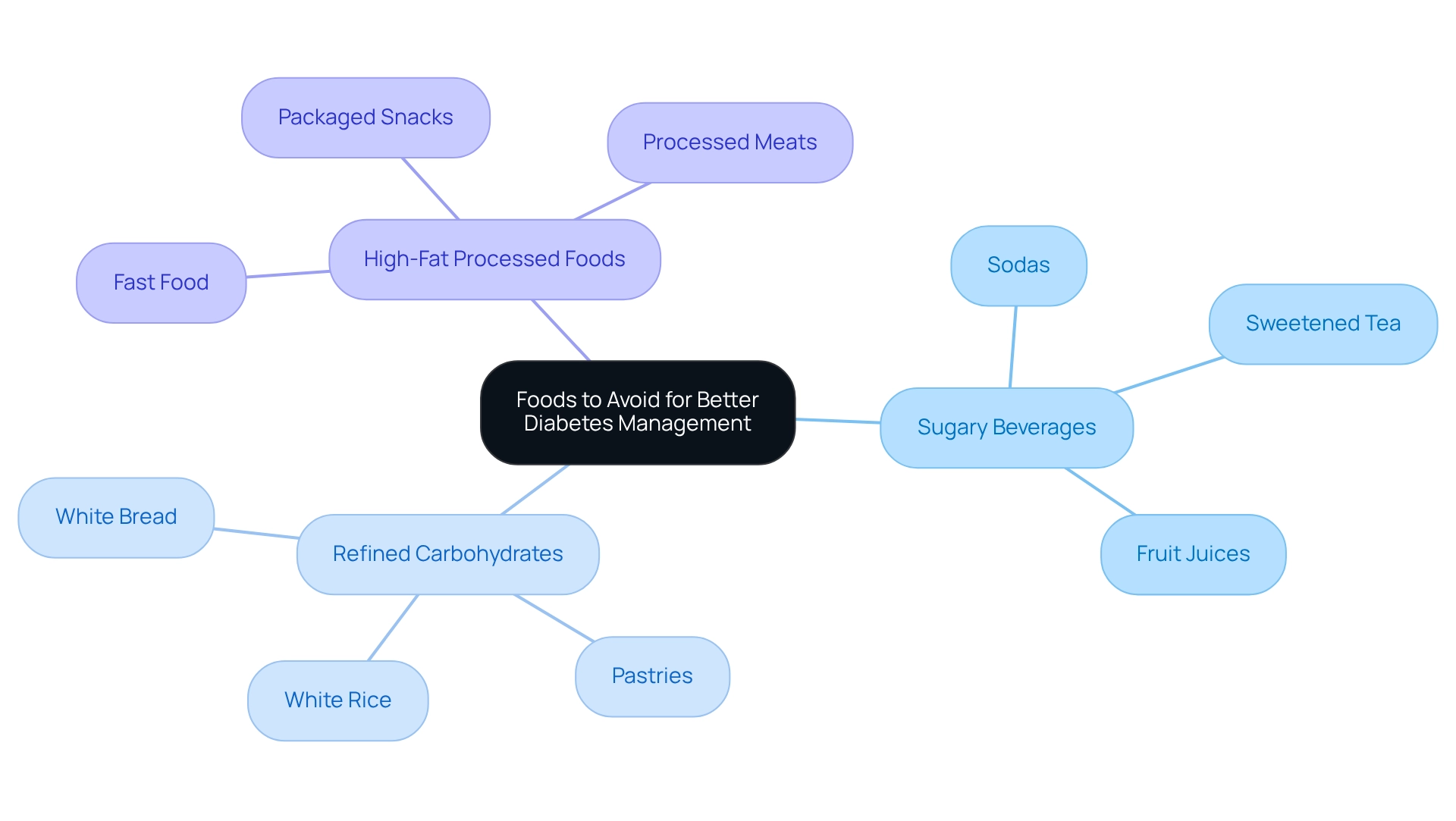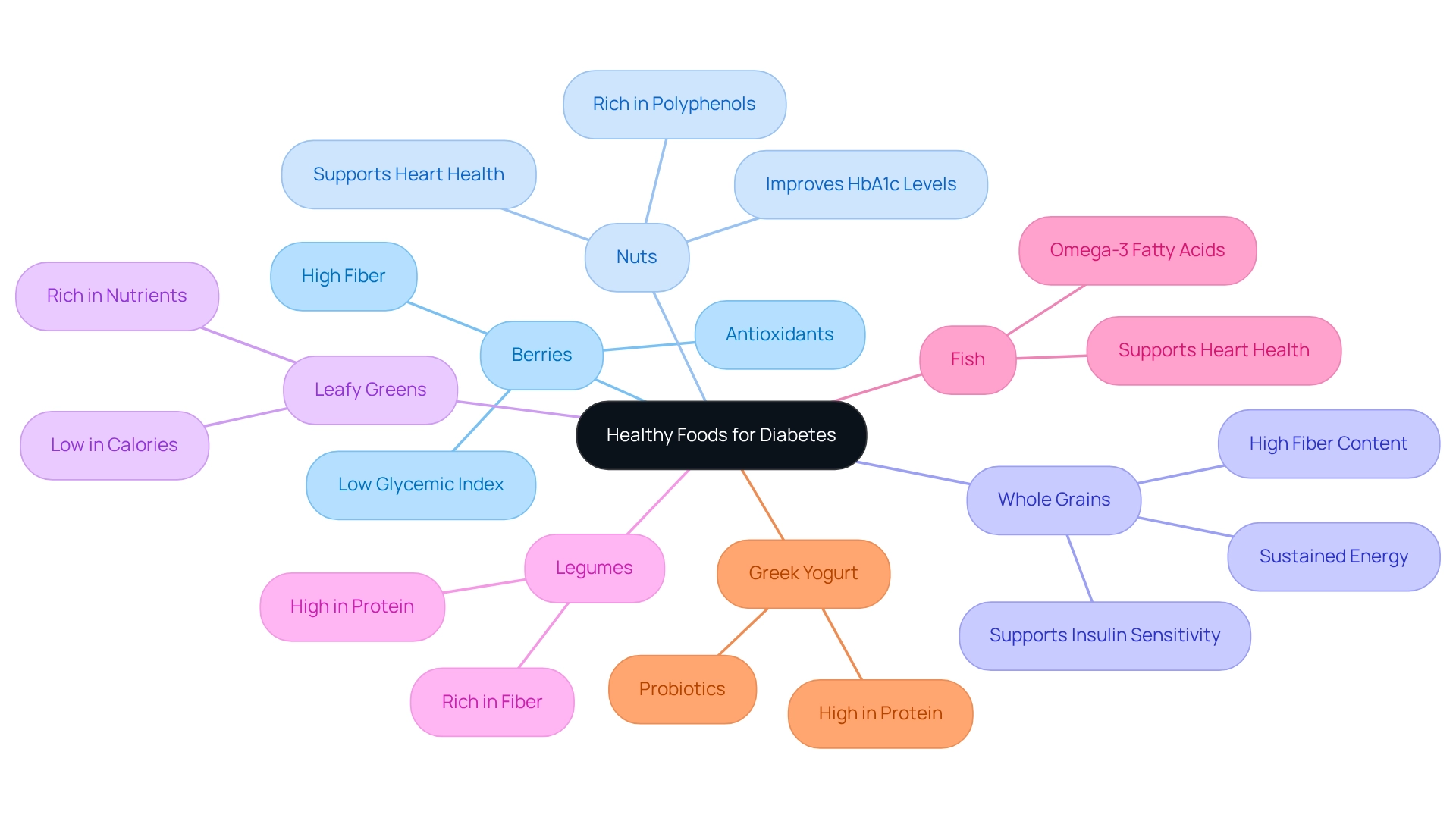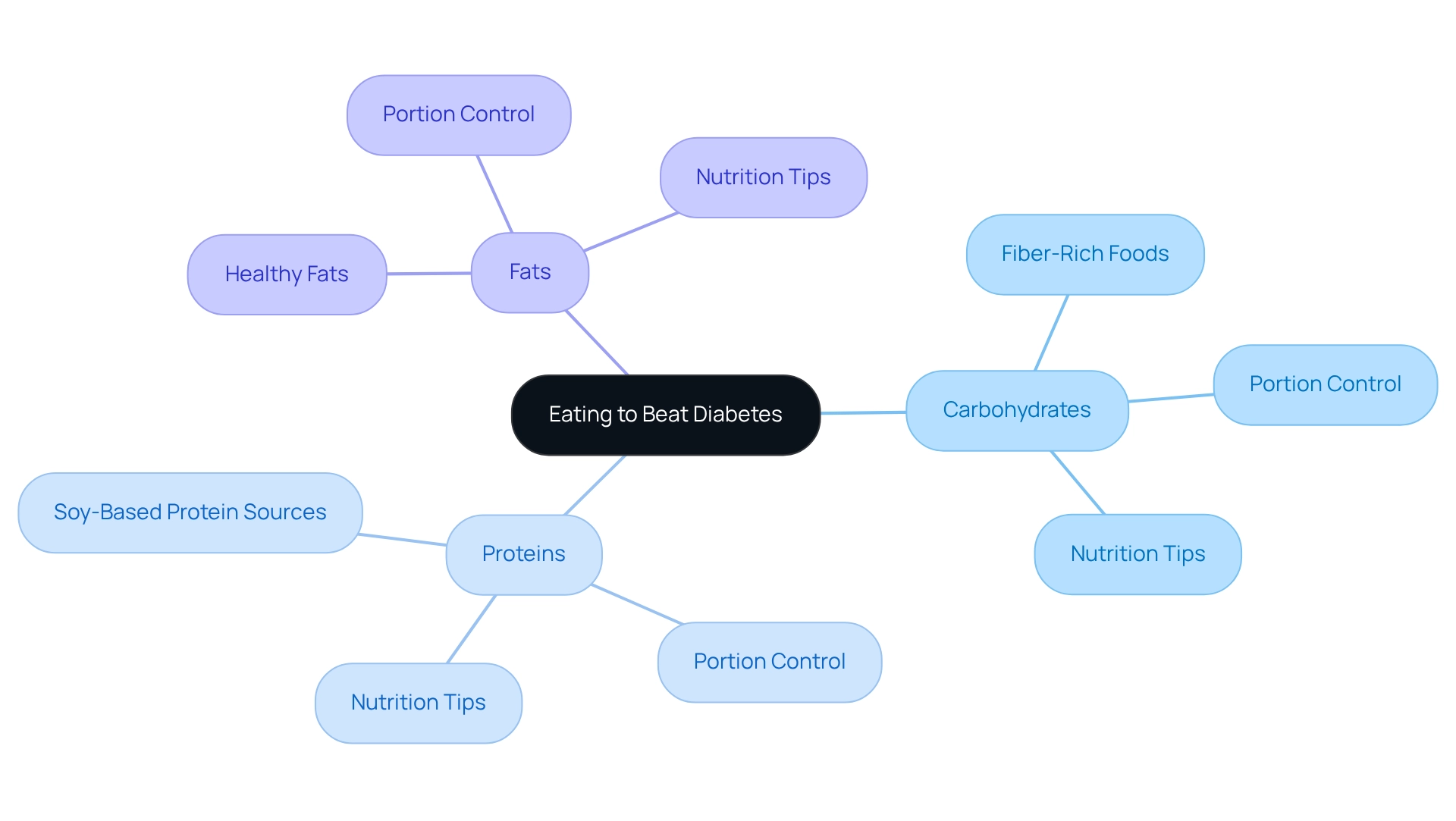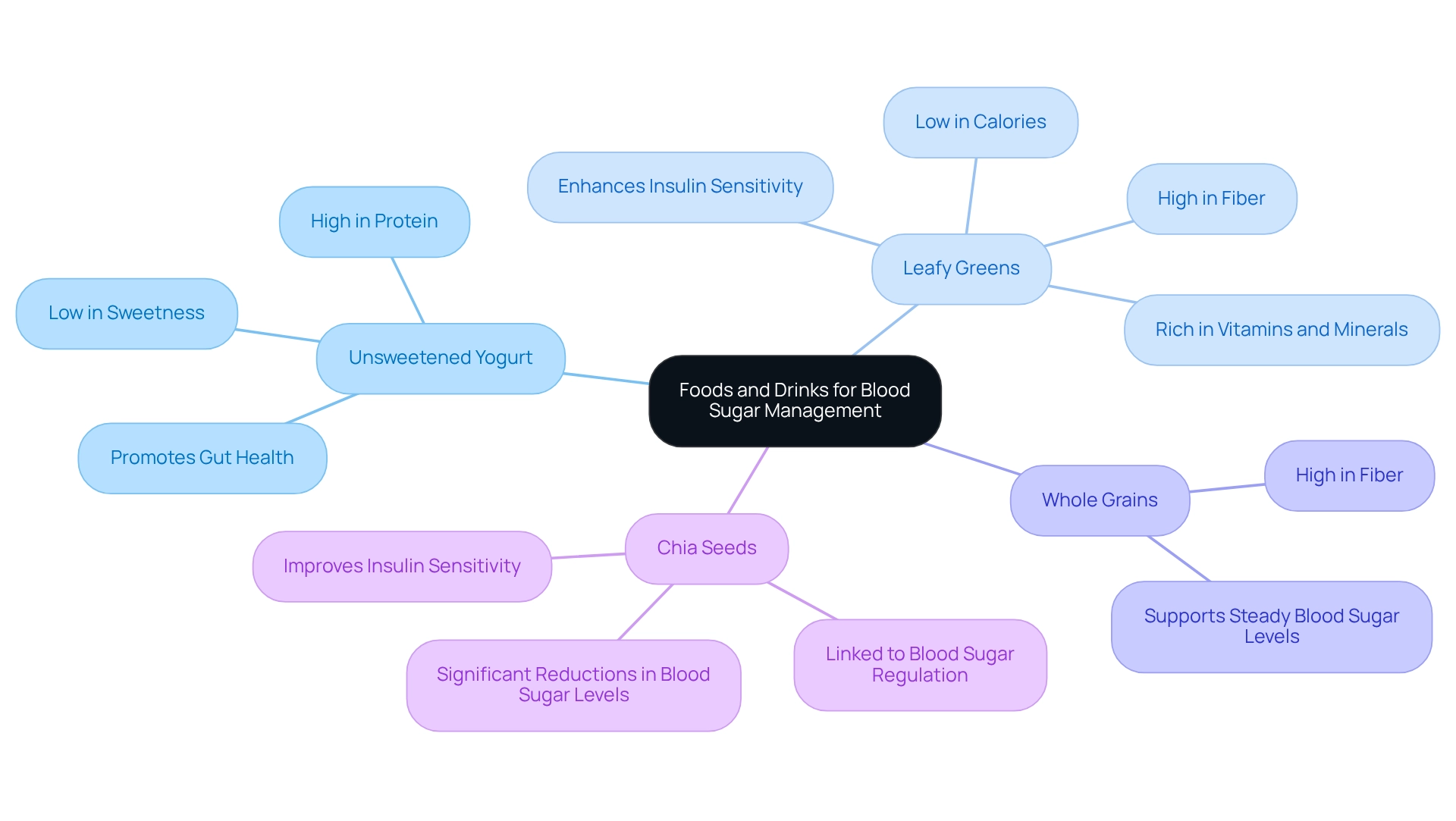Overview
The article titled “10 Essential Foods for Diabetics: A List of Food for Diabetics” is designed to help you navigate the challenges of managing diabetes. It’s important to recognize that making the right dietary choices can significantly impact your health. While specific food items aren’t listed, the article emphasizes the importance of incorporating nutrient-rich foods, such as:
- Whole grains
- Leafy greens
- Lean proteins
These choices are crucial for stabilizing blood sugar levels and enhancing your overall well-being. Many patients find that these dietary adjustments, supported by various programs and guidelines, can lead to a more balanced lifestyle. Remember, you’re not alone on this journey. Embracing these foods can be a step toward a healthier you, and we encourage you to explore the 30-Day Diabetes Reset program for more guidance and support.
Introduction
In the quest for effective diabetes management, dietary choices play a pivotal role in controlling blood sugar levels and enhancing overall health. It’s important to recognize that navigating the world of nutrition can feel overwhelming at times. The landscape of nutritional guidance is rich with resources, from comprehensive meal planning strategies to specific food recommendations that empower individuals to make informed choices.
Many patients find that having support in this journey makes a significant difference. This article delves into various programs and tools designed to support those living with diabetes, highlighting the importance of whole foods, balanced meals, and mindful eating habits. By exploring the latest insights and practical tips, readers will discover how to navigate their dietary landscape.
Ultimately, this journey can lead to improved health outcomes and a better quality of life, fostering a sense of hope and empowerment.
Integrative Wellness Center: 30-Day Diabetes Reset Program for Effective Dietary Management
Are you feeling overwhelmed by managing your diabetes? The 30-Day Diabetes Reset Program at the Integrative Wellness Center offers a holistic approach to dietary management designed just for you. This program equips participants with vital tools and knowledge to transform their eating habits, emphasizing whole foods, balanced meals, and portion control. Many patients find that by prioritizing education and support, they can take charge of their health, enabling them to make informed dietary choices that can significantly improve blood sugar control and overall well-being.
It’s important to recognize that effective dietary management can mitigate the risks associated with poorly controlled blood sugar levels. These risks can lead to severe complications such as amputations, vision loss, and kidney damage. Did you know that 10.4% of adults aged 18-44 years have A1C levels of 10% or higher? This statistic underscores the urgent need for effective dietary interventions. The program’s emphasis on whole ingredients aligns with current expert views that promote nutrient-rich diets to aid in managing blood sugar levels.
Real-world examples from participants demonstrate that dietary changes can lead to substantial improvements in health outcomes. One participant shared, “I never thought I could feel this good just by changing my diet!” This reinforces the program’s effectiveness. By fostering an environment of learning and empowerment, the 30-Day Diabetes Reset Program not only addresses immediate dietary needs but also promotes long-term health and wellness for individuals managing type 2 diabetes. Take the first step towards a healthier you today!
Zastic Laminated Diabetes Food Chart: Essential Grocery List for Diabetics
The Zastic Laminated Diabetes Grocery Chart is more than just a shopping list; it’s a vital resource for diabetics, thoughtfully categorizing items into ‘go’, ‘slow’, and ‘stop’ options based on their glycemic index and nutritional value. This chart empowers individuals to quickly recognize which foods to embrace and which to avoid, fostering healthier shopping habits and meal preparation. By utilizing this chart, diabetics can make informed choices that align with their health goals.
In San Marcos, CA, incorporating local produce such as avocados, berries, and leafy greens can significantly enhance the effectiveness of this chart. It’s important to recognize that understanding the glycemic index is crucial; dietitians highlight that foods with a high glycemic index, like sucrose with a GI of 65, can lead to spikes in blood sugar levels. Many patients find that tools like this chart are increasingly valuable for navigating grocery shopping, helping them select foods that positively impact their health.
Engaging with local farmers’ markets not only provides access to fresh, nutritious options but also supports community wellness initiatives. Imagine the joy of picking ripe, local fruits or crisp vegetables while connecting with your community! To further support blood sugar management, consider incorporating outdoor activities like hiking or walking in the scenic parks of San Marcos. These activities can uplift your physical health and mood.
Moreover, integrating stress management techniques such as yoga or mindfulness practices can offer additional support in maintaining balanced blood sugar levels. Real-life examples demonstrate that using grocery lists, particularly a list of food for diabetics guided by the nutrition guide for diabetes, can greatly enhance dietary choices and overall management of the condition. This is especially true when paired with the comprehensive lifestyle strategies available in the San Marcos region. Together, these approaches create a nurturing environment for managing diabetes and fostering well-being.
CDC Diabetes Meal Planning: Guidelines for Healthy Eating
The CDC offers crucial guidelines for diabetes meal planning, which includes a list of food for diabetics and emphasizes the importance of balanced meals that incorporate a variety of food groups. It’s important to recognize that a well-structured plate should consist of:
- Half non-starchy vegetables
- One-quarter lean protein
- One-quarter whole grains
This method not only helps in stabilizing glucose levels but also ensures that individuals obtain sufficient nutrients essential for overall health.
Many patients find that incorporating local produce such as avocados, berries, and leafy greens can further enhance their meal planning in San Marcos, CA. These items are abundant in fiber and vital nutrients, promoting overall well-being and efficient blood sugar management. Furthermore, engaging in community wellness initiatives can offer tailored nutrition guidance and assistance, simplifying adherence to these recommendations while enjoying the lively local culinary scene.
Have you considered joining us for our upcoming event? It’s a wonderful opportunity to obtain a complimentary copy of Dr. Jason Shumard’s book, which provides additional insights into managing health through personalized nutrition plans. By following these guidelines and utilizing a list of food for diabetics, individuals can take proactive steps toward achieving better health and an improved quality of life.
Healthline Diabetic-Friendly Grocery List: Foods to Support Blood Sugar Control
Managing diabetes can be challenging, but a list of food for diabetics can serve as a helpful tool in your journey. Healthline emphasizes essential foods that play a vital role in supporting sugar level management. Leafy vegetables, whole grains, lean proteins, and healthy fats are crucial components of a balanced dietary plan, which is vital for managing blood sugar levels and preventing complications. It’s important to recognize that research suggests including glucomannan can significantly reduce fasting glucose and cholesterol levels, showcasing the impact of specific dietary selections.
Many patients find that incorporating fatty fish, rich in omega-3 fatty acids, is associated with improved glucose regulation and a lower risk of developing type 2 conditions. Experts emphasize that a diet rich in greens not only aids in weight management but also enhances overall health. For instance, the intake of leafy greens has been linked to better glucose levels, which is why they should be included in a list of food for diabetics. By thoughtfully including these items in daily meals, individuals with glucose management issues can enhance their nutritional intake and effectively regulate their levels. This ultimately leads to improved health outcomes, fostering a sense of well-being and empowerment.
Diabetes Care Community: 10 Foods to Avoid for Better Diabetes Management
Managing diabetes can be challenging, and understanding which foods to avoid is a crucial step toward effective management. The Diabetes Care Community identifies ten essential foods to steer clear of, including:
- Sugary beverages
- Refined carbohydrates
- High-fat processed foods
Sweet beverages, in particular, can lead to rapid increases in sugar levels, making them a significant concern for those managing their condition. It’s important to recognize that a statistical analysis has shown changes in beverage consumption patterns can influence diabetes risk, with weight change explaining 7.1% of the linear trend between artificial sweetened beverage (ASB) consumption and diabetes risk.
Many patients find that refined carbohydrates, such as white bread and pastries, also pose a risk due to their potential to cause quick spikes in glucose levels. Dietitians emphasize that these items can disrupt glucose regulation, encouraging patients to opt for whole grains instead. Additionally, high-fat processed foods, often laden with harmful trans fats, can exacerbate insulin resistance, complicating the management of diabetes further.
Real-world examples illustrate the profound benefits of making dietary changes. Patients who have eliminated sugary beverages and refined carbohydrates from their diets often report improved blood sugar levels and overall health. This aligns with the views of specialists who stress the importance of making informed dietary choices to support blood sugar management. As Dr. Jason Shumard of Integrative Wellness Center wisely states, “By providing patients with actionable insights and practical tools, the center fosters an environment where individuals can reclaim their health and well-being.”
If you’re eager to learn more about effective management strategies and receive personalized guidance, consider reaching out to Dr. Shumard at Integrative Wellness Center or attending our next event for valuable resources. By recognizing which items to avoid, you can make healthier choices that significantly enhance your blood sugar management and overall wellness.
Good Sam Gwinnett: 7 Healthy Foods to Consider for Diabetes
Managing blood sugar levels can be challenging, and it’s important to recognize that you’re not alone in this journey. Good Sam Gwinnett provides a list of food for diabetics that includes seven nutritious items, such as:
- Berries
- Nuts
- Whole grains
These foods are not only rich in fiber but also packed with antioxidants and vital nutrients that play a crucial role in stabilizing glucose levels. For instance, clinical studies have shown that incorporating nuts, like almonds, into a low-carbohydrate diet can lead to significant improvements in HbA1c levels. This highlights the power of dietary changes in managing blood sugar effectively.
Berries are particularly noteworthy; their high fiber content and low glycemic index make them superb options for keeping blood sugar levels steady. They provide antioxidants that help combat oxidative stress, a common concern for those navigating blood sugar challenges. Whole grains also play a vital role, offering sustained energy and supporting insulin sensitivity.
It’s concerning that many diabetics often fall short of the recommended fiber intake, which is essential for optimal health. Nutritionists emphasize that increasing your consumption of fiber-rich foods can lead to better glycemic control and overall well-being. Incorporating a list of food for diabetics into your daily meals can enhance your health and support effective diabetes management, ultimately improving your quality of life. Remember, every small step counts on this journey toward better health.
WebMD Best and Worst Foods for Diabetics: A Comprehensive Guide
At WebMD, we understand that managing diabetes can be challenging, which is why we offer a list of food for diabetics to help you navigate the best and worst foods for your health. It’s important to recognize that the foods you choose can significantly impact your glucose levels. For instance, non-starchy vegetables, whole grains, and lean proteins are excellent choices that can help stabilize your blood sugar and enhance your overall well-being. Conversely, sugary snacks, refined grains, and fatty meats should be avoided, as they can lead to spikes in blood sugar and long-term health complications.
Many patients find that incorporating non-starchy vegetables into their meals is especially beneficial due to their low carbohydrate content and high fiber, which assist in regulating glucose levels. Additionally, certain supplements may also contribute positively to your overall health and blood sugar management. Did you know that 8.0% of adults with diagnosed conditions have non-HDL cholesterol levels of 190 mg/dL or higher? This statistic underscores the importance of making dietary adjustments to reduce cardiovascular risks associated with diabetes.
It’s also crucial to acknowledge the role of physical activity in managing your condition. With 31.9% of adults with diabetes being physically inactive, incorporating exercise into your routine can enhance your dietary efforts in regulating blood sugar levels. Furthermore, integrating stress management techniques—such as mindfulness practices and relaxation exercises—can further support your journey toward better blood sugar control, particularly when combined with a list of food for diabetics that experts consistently emphasize as important in managing diabetes. By making informed dietary choices and embracing holistic lifestyle strategies, you can significantly improve your health outcomes and quality of life. This comprehensive approach not only addresses your immediate dietary needs but also fosters long-term wellness, empowering you to take control of your health journey.
Medical News Today: Healthier Foods for People with Diabetes
Recent insights highlight the vital role of incorporating a list of food for diabetics into the diets of individuals with diabetes. Legumes, whole grains, and low-fat dairy products are important items to include in a list of food for diabetics that can make a significant difference. In San Marcos, CA, local farmers’ markets provide a wonderful variety of fresh, seasonal produce, such as avocados and berries, which can be part of a list of food for diabetics. These nutrient-dense options are part of a list of food for diabetics, as they provide essential vitamins and minerals while playing a crucial role in maintaining stable glucose levels. Many patients find that legumes, which feature prominently in a list of food for diabetics, are rich in fiber and protein, helping to regulate glucose levels and enhance feelings of fullness. As dietitian Kim Rose-Francis wisely notes, ‘fish is also an excellent source of high-quality protein, which aids in feeling full and helps stabilize sugar levels.’
It’s important to recognize that incorporating a variety of carbohydrates, lean proteins, and healthy fats—especially through the Mediterranean diet and principles of the glycemic index—can lead to remarkable improvements in blood glucose and cholesterol levels, which can be guided by a list of food for diabetics. A case study titled ‘Empowerment Through Dietary Changes’ illustrates how small adjustments, such as increasing the intake of legumes and whole grains, can transform one’s relationship with nutrition, which can be part of a list of food for diabetics, turning it into an empowering aspect of diabetes management.
Furthermore, current dietary guidelines recommend aiming for less than 2,300 mg of sodium daily, underscoring the necessity for mindful eating choices. Adding a serving of local fruit or low-fat dairy alongside meals, paired with water or unsweetened tea, can enhance nutritional intake while keeping blood sugar levels in check. Engaging with local farmers’ markets not only grants access to fresh produce but also fosters community connections that can support overall wellness. Regular exercise, such as walking or hiking in the scenic parks of San Marcos, complements these dietary choices by improving insulin sensitivity and promoting a healthy lifestyle. By adopting these more nutritious food choices and participating in community wellness initiatives in San Marcos, individuals can enhance their overall health and take proactive steps in managing their condition effectively.
Kaiser Permanente: Eating to Beat Diabetes Tips for Food Balance
Managing diabetes can feel overwhelming at times, but it’s important to recognize that finding balance in your meals can make a significant difference. Kaiser Permanente highlights the essential role of carbohydrates, proteins, and fats in your diet. One effective strategy is the plate method, which helps you visualize portion sizes. By focusing on meals rich in fiber and low in added sweeteners, you can not only maintain stable blood sugar levels but also support your overall health.
Many patients find that a well-balanced diet enhances their blood sugar management. In fact, recent studies show that six out of seven interventions positively impact lipoprotein levels. Nutritionists emphasize this balance as crucial for optimizing metabolic health. By concentrating on nutrient-dense foods and practicing portion control, you can take proactive steps toward better diabetes management and improved well-being.
Have you considered how your dietary choices could influence your health? Reflecting on this can empower you to make informed decisions. Remember, you are not alone in this journey; support is available through programs like the 30-Day Diabetes Reset. Together, we can navigate these challenges and work towards a healthier future.
Nutrition News Abbott: 10 Foods and Drinks to Help Manage Blood Sugar
Recent insights emphasize ten vital items and beverages that can effectively assist in regulating glucose levels, including unsweetened yogurt, leafy greens, and whole grains. It’s important to recognize that these items are not only nutrient-rich but also high in fiber, which is essential for managing glucose levels. For instance, many patients find that consuming apples 30 minutes before a rice meal can considerably lower post-meal glucose levels, illustrating the positive impact of intentional food choices.
Including unsweetened yogurt in daily meals can offer various advantages for individuals with diabetes. This dairy option is low in sweetness and high in protein, which can help in controlling glucose levels. Nutritionists highlight that unsweetened yogurt also promotes gut health, further supporting metabolic functions. Have you considered how a simple addition like this could transform your meals?
Leafy greens, such as spinach and kale, are another powerhouse for managing glucose levels. They are low in calories and carbohydrates while being rich in vitamins and minerals. Their high fiber content aids in enhancing insulin sensitivity, making them an excellent choice for those navigating diabetes. Many patients share that incorporating these greens into their diet has made a noticeable difference in their overall health.
Moreover, chia seeds have been linked to significant advancements in glucose regulation. Research shows that their intake can lead to meaningful decreases in blood sugar levels, reinforcing their role in a diet suitable for those with blood sugar concerns. Have you tried adding chia seeds to your meals yet?
Participating in community wellness initiatives can further enhance these dietary selections by providing valuable assistance and resources tailored for managing blood sugar. By integrating these foods into daily meals and taking advantage of community support, individuals can strengthen their diabetes management strategies. This approach can ultimately lead to improved health outcomes and a better quality of life. Remember, you’re not alone on this journey—support is available, and small changes can lead to significant improvements.
Conclusion
In summary, the journey toward effective diabetes management can feel overwhelming, yet it is significantly shaped by informed dietary choices and supportive resources. Programs like the 30-Day Diabetes Reset at the Integrative Wellness Center offer individuals the tools and knowledge necessary to transform their eating habits. They emphasize the importance of whole foods, balanced meals, and portion control. By prioritizing education and community support, these initiatives empower individuals to take charge of their health, leading to improved blood sugar control and overall well-being.
It’s important to recognize that practical resources, such as the Zastic Laminated Diabetes Food Chart and the CDC’s meal planning guidelines, can be invaluable in navigating dietary choices. Many patients find that understanding the glycemic index and making conscious food selections helps them avoid harmful foods while embracing those that stabilize blood sugar levels. Incorporating nutrient-dense options like leafy greens, whole grains, and healthy fats not only supports diabetes management but also enhances overall health.
Ultimately, the integration of dietary strategies with lifestyle changes—such as physical activity and stress management—creates a holistic approach to diabetes care. By adopting these practices and utilizing available resources, individuals can significantly improve their health outcomes and quality of life. This proactive stance fosters a sense of empowerment, enabling those living with diabetes to navigate their dietary landscape with confidence and purpose.
Frequently Asked Questions
What is the 30-Day Diabetes Reset Program at the Integrative Wellness Center?
The 30-Day Diabetes Reset Program is a holistic approach to dietary management designed to help individuals manage their diabetes. It provides participants with tools and knowledge to transform their eating habits, focusing on whole foods, balanced meals, and portion control.
How does the program help improve blood sugar control?
The program emphasizes education and support, enabling participants to make informed dietary choices that can significantly improve blood sugar control and overall well-being.
What are the risks associated with poorly controlled blood sugar levels?
Poorly controlled blood sugar levels can lead to severe complications such as amputations, vision loss, and kidney damage.
What is the Zastic Laminated Diabetes Grocery Chart?
The Zastic Laminated Diabetes Grocery Chart is a resource for diabetics that categorizes food items into ‘go’, ‘slow’, and ‘stop’ options based on their glycemic index and nutritional value, helping individuals make informed shopping choices.
How can local produce enhance the effectiveness of the grocery chart?
Incorporating local produce, such as avocados, berries, and leafy greens, can significantly improve dietary choices and align with health goals when using the grocery chart.
What are the CDC guidelines for diabetes meal planning?
The CDC guidelines suggest that a well-structured plate should consist of half non-starchy vegetables, one-quarter lean protein, and one-quarter whole grains to help stabilize glucose levels and ensure sufficient nutrient intake.
What additional strategies can support blood sugar management?
Engaging in outdoor activities, practicing stress management techniques like yoga or mindfulness, and participating in community wellness initiatives can further support blood sugar management.
How can individuals access further resources for managing diabetes?
Individuals can join community events to obtain resources such as Dr. Jason Shumard’s book, which offers insights into managing health through personalized nutrition plans.
